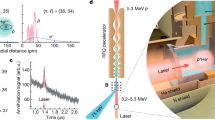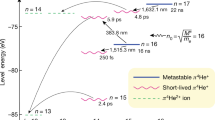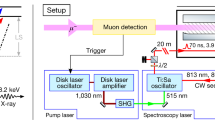Abstract
Physical laws are believed to be invariant under the combined transformations of charge, parity and time reversal (CPT symmetry1). This implies that an antimatter particle has exactly the same mass and absolute value of charge as its particle counterpart. Metastable antiprotonic helium ( He+) is a three-body atom2 consisting of a normal helium nucleus, an electron in its ground state and an antiproton (
He+) is a three-body atom2 consisting of a normal helium nucleus, an electron in its ground state and an antiproton ( ) occupying a Rydberg state with high principal and angular momentum quantum numbers, respectively n and l, such that n ≈ l + 1 ≈ 38. These atoms are amenable to precision laser spectroscopy, the results of which can in principle be used to determine the antiproton-to-electron mass ratio and to constrain the equality between the antiproton and proton charges and masses. Here we report two-photon spectroscopy of antiprotonic helium, in which
) occupying a Rydberg state with high principal and angular momentum quantum numbers, respectively n and l, such that n ≈ l + 1 ≈ 38. These atoms are amenable to precision laser spectroscopy, the results of which can in principle be used to determine the antiproton-to-electron mass ratio and to constrain the equality between the antiproton and proton charges and masses. Here we report two-photon spectroscopy of antiprotonic helium, in which  3He+ and
3He+ and  4He+ isotopes are irradiated by two counter-propagating laser beams. This excites nonlinear, two-photon transitions of the antiproton of the type (n, l) → (n − 2, l − 2) at deep-ultraviolet wavelengths (λ = 139.8, 193.0 and 197.0 nm), which partly cancel the Doppler broadening of the laser resonance caused by the thermal motion of the atoms. The resulting narrow spectral lines allowed us to measure three transition frequencies with fractional precisions of 2.3–5 parts in 109. By comparing the results with three-body quantum electrodynamics calculations, we derived an antiproton-to-electron mass ratio of 1,836.1526736(23), where the parenthetical error represents one standard deviation. This agrees with the proton-to-electron value known to a similar precision.
4He+ isotopes are irradiated by two counter-propagating laser beams. This excites nonlinear, two-photon transitions of the antiproton of the type (n, l) → (n − 2, l − 2) at deep-ultraviolet wavelengths (λ = 139.8, 193.0 and 197.0 nm), which partly cancel the Doppler broadening of the laser resonance caused by the thermal motion of the atoms. The resulting narrow spectral lines allowed us to measure three transition frequencies with fractional precisions of 2.3–5 parts in 109. By comparing the results with three-body quantum electrodynamics calculations, we derived an antiproton-to-electron mass ratio of 1,836.1526736(23), where the parenthetical error represents one standard deviation. This agrees with the proton-to-electron value known to a similar precision.
This is a preview of subscription content, access via your institution
Access options
Subscribe to this journal
Receive 51 print issues and online access
$199.00 per year
only $3.90 per issue
Buy this article
- Purchase on Springer Link
- Instant access to full article PDF
Prices may be subject to local taxes which are calculated during checkout
 He+.
He+. 



Similar content being viewed by others
References
Bluhm, R., Kostelecký, V. A. & Russell, N. CPT and Lorentz tests in hydrogen and antihydrogen. Phys. Rev. Lett. 82, 2254–2257 (1999)
Hayano, R. S., Hori, M., Horváth, D. & Widmann, E. Testing CPT invariance with antiprotonic helium. Rep. Prog. Phys. 70, 1995–2065 (2007)
Korobov, V. I. Calculations of transitions between metastable states of antiprotonic helium including relativistic and radiative corrections of order R∞α4 . Phys. Rev. A 77, 042506 (2008)
Hori, M. et al. Direct measurement of transition frequencies in isolated p̄He+ atoms, and new CPT-violation limits on the antiproton charge and mass. Phys. Rev. Lett. 91, 123401 (2003)
Hori, M. et al. Determination of the antiproton-to-electron mass ratio by precision laser spectroscopy of p̄He+ . Phys. Rev. Lett. 96, 243401 (2006)
Parthey, C. G. et al. Precision measurement of the hydrogen-deuterium 1s-2s isotope shift. Phys. Rev. Lett. 104, 233001 (2010)
Gabrielse, G. et al. Antihydrogen production within a Penning-Ioffe trap. Phys. Rev. Lett. 100, 113001 (2008)
Andresen, G. B. et al. Trapped antihydrogen. Nature 468, 673–676 (2010)
Hori, M. & Korobov, V. I. Calculation of transition probabilities and ac Stark shifts in two-photon laser transitions of antiprotonic helium. Phys. Rev. A 81, 062508 (2010)
Bjorkholm, J. E. & Liao, P. F. Resonant enhancement of two-photon absorption in sodium vapor. Phys. Rev. Lett. 33, 128–131 (1974)
Hori, M. & Dax, A. Chirp-corrected, nanosecond Ti:sapphire laser with 6 MHz linewidth for spectroscopy of antiprotonic helium. Opt. Lett. 34, 1273–1275 (2009)
Udem, Th., Holzwarth, R. & Hänsch, T. W. Optical frequency metrology. Nature 416, 233–237 (2002)
Meyer, V. et al. Measurement of the 1s-2s energy interval in muonium. Phys. Rev. Lett. 84, 1136–1139 (2000)
Eikema, K. S. E., Ubachs, W., Vassen, W. & Hogervorst, W. Lamb shift measurement in the 11S ground state of helium. Phys. Rev. A 55, 1866–1884 (1997)
Bakule, P. et al. A chirp-compensated, injection-seeded alexandrite laser. Appl. Phys. B 71, 11–17 (2000)
Korobov, V. I. Hyperfine structure of metastable states in 3He+p̄ . Phys. Rev. A 73, 022509 (2006)
Bakalov, D., Jeziorski, B., Korona, T. & Szalewicz, K. &. Tchoukova, E. Density shift and broadening of transition lines in antiprotonic helium. Phys. Rev. Lett. 84, 235–238 (2000)
Hori, M. et al. Sub-ppm laser spectroscopy of antiprotonic helium and a CPT-violation limit on the antiprotonic charge and mass. Phys. Rev. Lett. 87, 093401 (2001)
Mohr, P. J. & Taylor, B. N. CODATA recommended values of the fundamental constants: 2002. Rev. Mod. Phys. 77, 1–107 (2005)
Pohl, R. et al. The size of the proton. Nature 466, 213–216 (2010)
Van Dyck, R. S., Jr Moore, F. L., Farnham, D. L. & Schwinberg, P. B. Improved measurement of proton-electron mass ratio. Bull. Am. Phys. Soc. 31, 244–244 (1986)
Farnham, D. L., Van Dyck, R. S., Jr & Schwinberg, P. B. Determination of the electron’s atomic mass and the proton/electron mass ratio via Penning trap mass spectroscopy. Phys. Rev. Lett. 75, 3598–3601 (1995)
Beier, T. et al. New determination of the electron’s mass. Phys. Rev. Lett. 88, 011603 (2002)
Verdú, J. et al. Electronic g factor of hydrogenlike oxygen 16O7+ . Phys. Rev. Lett. 92, 093002 (2004)
Koelemeij, J. C. J., Roth, B., Wicht, A. & Ernsting, I. &. Schiller, S. Variational spectroscopy of HD+ with 2-ppb accuracy. Phys. Rev. Lett. 98, 173002 (2007)
Hughes, R. J. & Deutch, B. I. Electric charges of positrons and antiprotons. Phys. Rev. Lett. 69, 578–581 (1992)
Nakamura, K. et al. Review of particle physics. J. Phys. G 37, 075021 (2010)
Gabrielse, G. et al. Precision mass spectroscopy of the antiproton and proton using simultaneously trapped particles. Phys. Rev. Lett. 82, 3198–3201 (1999)
Thompson, J. K., Rainville, S. & Pritchard, D. E. Cyclotron frequency shifts arising from polarization forces. Nature 430, 58–61 (2004)
Fendel, P., Bergeson, S. D., Udem & Hänsch, T. W. Two-photon frequency comb spectroscopy of the 6s-8s transition in cesium. Opt. Lett. 32, 701–703 (2007)
Acknowledgements
This work was supported by the European Science Foundation (EURYI), Monbukagakusho (grant no. 20002003), the Munich Advanced Photonics cluster of the Deutsche Forschungsgemeinschaft, the Hungarian Research Foundation (K72172) and the Austrian Federal Ministry of Science and Research. We thank the CERN Antiproton Decelerator and Proton Synchrotron operational staff, the CERN cryogenics laboratory, J. Alnis, D. Bakalov, J. Eades, R. Holzwarth, V. I. Korobov, M. Mitani, W. Pirkl and T. Udem.
Author information
Authors and Affiliations
Contributions
M.H. designed the two-photon experiment. M.H. and A.D. developed the laser systems and carried out the caesium and rubidium measurements. M.H. and D.B. constructed the cryogenic target. M.H. developed the antiproton beam profile monitors, Cherenkov counters, cryogenic optics and data acquisition system. D.B. and M.H. wrote the analysis software. All authors contributed to the beam-time data taking and analysis. M.H. wrote the manuscript and all authors discussed the results and contributed to the editing.
Corresponding author
Ethics declarations
Competing interests
The authors declare no competing financial interests.
Rights and permissions
About this article
Cite this article
Hori, M., Sótér, A., Barna, D. et al. Two-photon laser spectroscopy of antiprotonic helium and the antiproton-to-electron mass ratio. Nature 475, 484–488 (2011). https://doi.org/10.1038/nature10260
Received:
Accepted:
Published:
Issue Date:
DOI: https://doi.org/10.1038/nature10260
This article is cited by
-
Test of charged baryon interaction with high-resolution vibrational spectroscopy of molecular hydrogen ions
Nature Physics (2023)
-
High-resolution laser resonances of antiprotonic helium in superfluid 4He
Nature (2022)
-
Laser Spectroscopy Measurements of Metastable Pionic Helium Atoms at Paul Scherrer Institute
Few-Body Systems (2021)
-
Fundamental symmetry tested using antihydrogen
Nature (2020)
-
Laser spectroscopy of pionic helium atoms
Nature (2020)
Comments
By submitting a comment you agree to abide by our Terms and Community Guidelines. If you find something abusive or that does not comply with our terms or guidelines please flag it as inappropriate.



